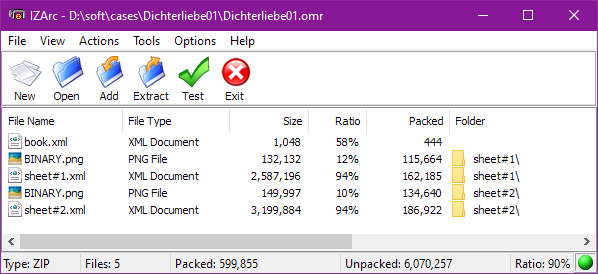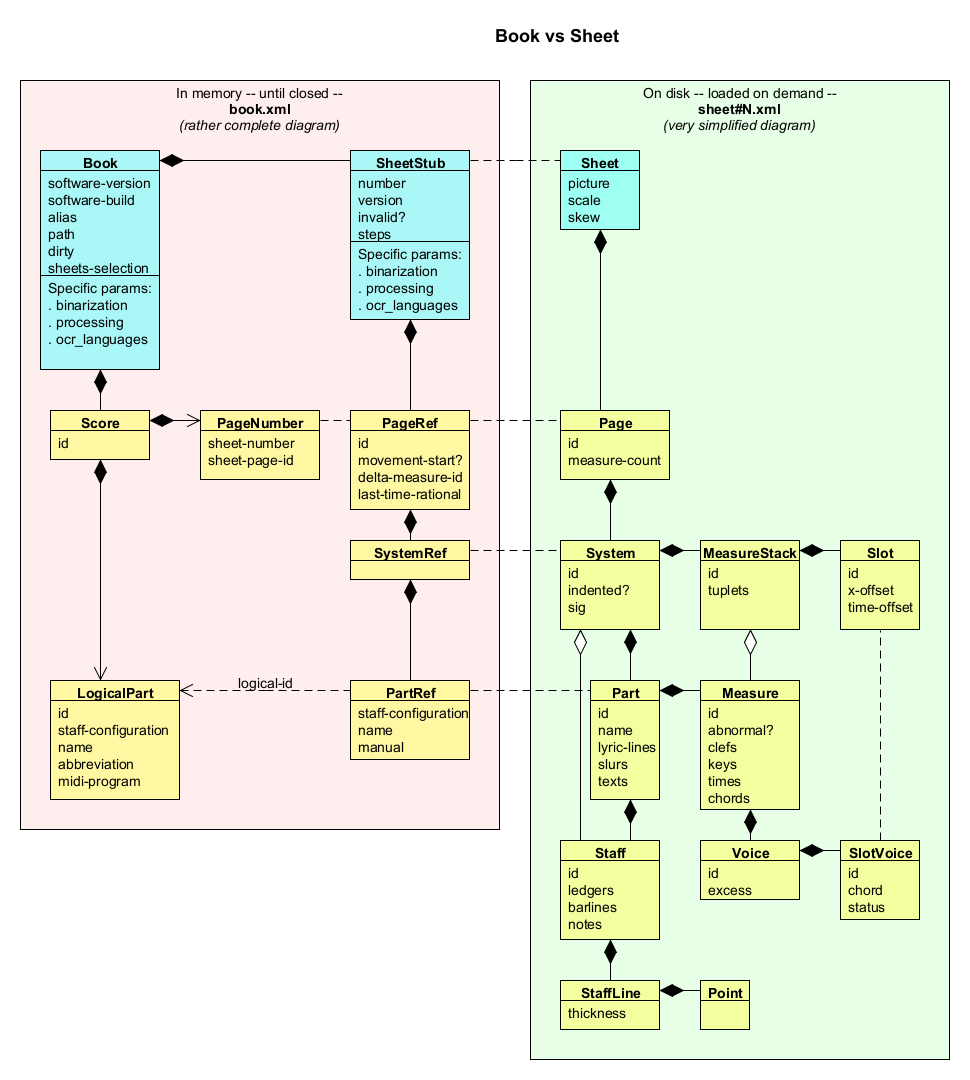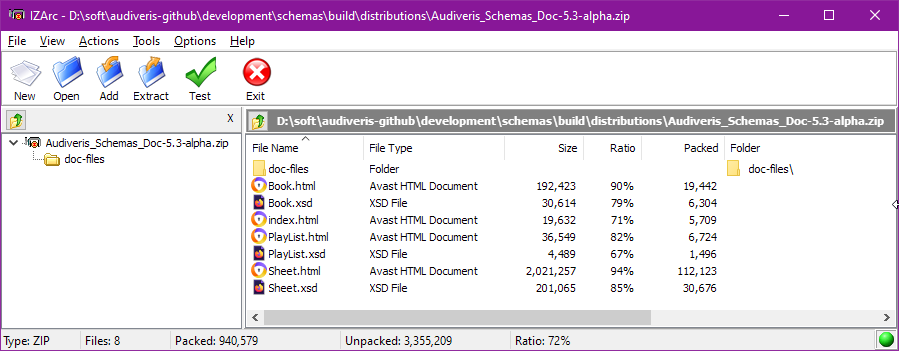.omr files
A .omr file is Audiveris project file for a given image(s) input file (book).
It gathers all OMR information related to a given Book, including its contained Sheet instances.
The project file is merely the result of the XML marshalling of a book and its sheets, so there is no logical difference in the project structure in memory and on disk. In memory there are a few additional transient variables, meant only for processing speedup.
This identical structuring between memory and disk allows the gradual processing of books of any size, since data can be continuously saved to (and restored from) disk while sheets are being processed.
All other Audiveris outputs derive from this project data.
File structure
The internal project structure is specific to Audiveris software but, as opposed to commercial software, it is not opaque and is meant for public access, either via Audiveris API or by direct access to project XML fragments.
The file is a collection of XML files gathered into a Zip archive, whose content can be easily browsed (and even modified – at your own risk!…) via any Zip reader or editor.

The picture above is a Zip view on a 2-sheet book (Dichterliebe01.omr example).
Here below is the same example, presented as a tree:
├── book.xml
├── sheet#1
│ ├── BINARY.png
│ └── sheet#1.xml
└── sheet#2
├── BINARY.png
└── sheet#2.xml
As you can see, we have in this .omr file example:
- A single
book.xmlfile - One
sheet#Nsubfolder for each sheet in the book, which here contains:- A
BINARY.pngfile - A
sheet#N.xmlfile
- A
Beyond this small example, here below are all the possible file kinds:
| File Name | Content |
|---|---|
book.xml | Skeleton of book hierarchy |
| sheet#N/ | Specific folder for sheet #N |
sheet#N/BINARY.png | Black and white image of sheet #N |
sheet#N/GRAY.png | Gray image of sheet #N |
sheet#N/HEAD_SPOTS.png | Head spots image for sheet #N |
sheet#N/sheet#N.xml | OMR details for sheet #N |
You may have noticed two files that did not appear in our small example, namely GRAY.png and HEAD_SPOTS.png:
GRAY.pngimage is built from the sheet original input image (which may be a colored image, perhaps with an alpha channel) and results in pixel gray values.
TheBINARYstep processes this gray image to produce the black and whiteBINARY.pngimage, which is needed by all subsequent steps. By default, the gray image is then discarded.
One case where theGRAY.pngimage would still be useful is when the user would want to modify the image geometry, typically by rotating or de-warping – features not yet provided as of this writing. In that case, quality would be better preserved when operating on gray rather than binary image.HEAD_SPOTS.pngimage is a temporary information carried over fromBEAMSstep toHEADSstep. It takes advantage of the image processing performed during theBEAMSstep to provide the image areas (spots) where black heads are likely to be recognized.
This image is discarded at the end ofHEADSstep.
Memory constraint
To be able to handle books with more than a few sheets, Audiveris keeps book top data in memory, while sheet “details” are loaded only when they are really needed.
In terms of project file, this means that the book.xml part is kept in memory until the book is closed, while the various sheet#N/BINARY.png and sheet#N/sheet#N.xml are loaded on demand.
So, the physical and logical containments are implemented as follows:
- A
Bookdoes not directly containSheetinstances but only a sequence of SheetStub instances (or Stub for short) with a one-to-one relationship betweenSheetStubandSheet. - In a similar manner, a
Scoreactually contains PageRef instances which refer toPageinstances.
In the following class diagram, physical entities are displayed in blue, and logical entities in yellow.

On the left side, the book.xml artifact represents the content of the book.xml part within an Audiveris project file, and is kept in memory. Note that the Score and PageRef instances can exist only when GRID step has been reached on (some sheets of) the book.
On the right side, the sheet#N.xml artifact represents one sheet (perhaps among others), pointed to from book.xml, and is not necessarily in memory.
[NOTA: Just to avoid endless clashes with Java predefined System class, we have chosen SystemInfo as the class name to represent a music system]
Schemas documentation
We wanted to make .omr file as open as possible to let end-users and developers use directly this file for any purpose compliant with Audiveris AGPL license.
To this end, we have developed a specific documentation set.
For each of the two kinds of XML files (book.xml and sheet#N.xml) we provide:
- The corresponding formal schema description as a
.xsdfile.
This.xsdfile can be further used to automatically:- Generate a binding between the XML file and a coding language such as Java.
- Validate the XML file produced by another source such as a test program.
- The corresponding schema documentation as a
.htmlfile meant for a human reader. It documents the various elements and attributes of the XML hierarchy, augmented by JavaDoc annotations from Audiveris source code.
Since Audiveris 5.3, the Split & Merge feature can accept play-list definitions created via Audiveris UI or provided as XML files created by any plain text editor.
Consequently, we provide an additional .xsd + .html pair, this time for a playlist.xml file.
Documentation distribution
We could not integrate the schemas documentation set into Audiveris HandBook on GitHub Pages.
Please tell us if we are wrong, but we could not use GitHub Pages for two reasons:
- Putting large
.htmlfiles under GitHub Pages source control would be an awful waste of resources - GitHub Pages would serve these
.htmlfiles with incorrect mime type.
They would be served as plain text files, preventing suitable rendering by any web browser.
So, for the time being, Audiveris schemas documentation is packed as a ZIP archive and simply published side by side with most recent releases available on Audiveris Releases section at GitHub site. Typical file name is Audiveris_Schemas_Doc-X.Y.Z.zip, where X.Y.Z is the precise release version.
For example, here is the content of a recent version:

You can simply download and expand this ZIP archive locally, to get an easy access to its content.
-
The
.xsdfiles are available for a picking. -
The HTML documentation can be browsed from the
index.htmlroot file. The various HTML pieces use links to images stored in thedoc-filessub-folder.
Documentation generation
If, as a developer, you want to (re-)generate this documentation set on your own, please refer to Building Schemas Documentation article in Audiveris Wiki.